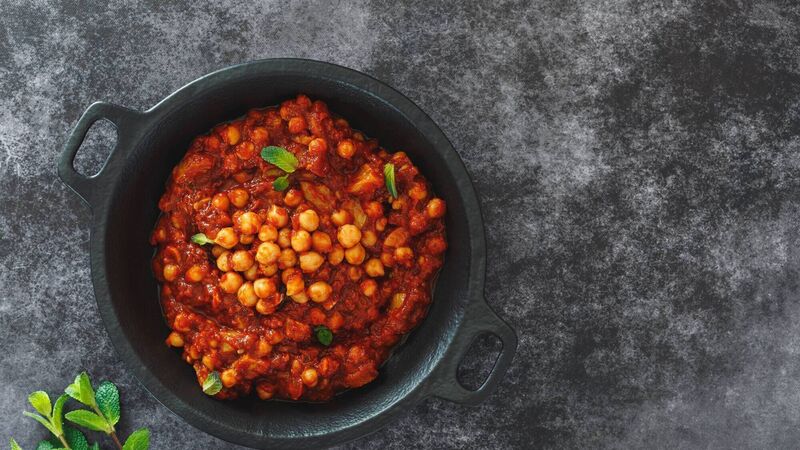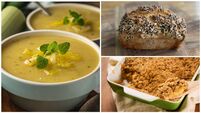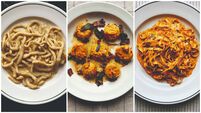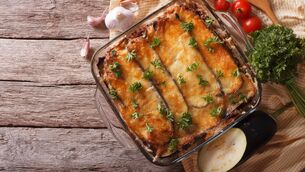Darina Allen: Stop Food Waste Day 2022 and 11 ways to save on your weekly food bill

This Moroccan-style stew is made with leftovers.
Stop Food Waste Day on April 27 this year is all about raising awareness, igniting change and identifying more ways to change our behaviour and minimise food waste.
You’ll all be familiar with at least some of the statistics. 33% of all the food produced globally is lost or wasted but did you know that 45% of all root crops grown never reach the table.
Just 25% of all the food wasted could feed all the 95 million undernourished people in the world and 8% of all the greenhouse gas emissions each year are due to food loss or waste. Shameful statistics – a massive issue for the planet and each and every one of us.
Here at the Ballymaloe Cookery School, even though we’ve got a strong focus on Zero Waste, we’ve still on a journey, gradually discovering and sharing more innovative ways to avoid food waste, we continue to encourage students to be mindful about simple things like throwing the veg peelings and herb stalks into the stock pot rather than the bin. Scraps that don’t qualify for the stock pot go into the hen’s bucket in every kitchen to be recycled by the hens to come back as beautiful fresh eggs a few days later. The shells go back into the hen’s bucket to add calcium to the shells of future eggs (and no it doesn’t encourage them to peck the shells of freshly laid eggs!).
For many, unconscious wasting has become an acceptable way of life – it may surprise many to realise that this is a relatively new phenomenon. When I was a child in the 1950’s, waste was not an option, all leftover scraps were used up deliciously, clothes and machinery were mended rather than discarded and built-in obsolescence was not a thing. Hopefully as public opinion becomes more intolerant of the mantra ‘better to buy new than to fix, companies will be forced to rethink their policies.
But back to food and what we can do in our homes and restaurants. Cheap food is certainly part of the problem – ‘easy come, easy go’ but with cost spiralling, working towards a ‘Zero Waste’ policy in our homes or businesses was never more timely. It may take a fundamental change in mindset for all the family or team but quite quickly it can become part of the ethos with everyone entering into the spirit. There’s also a brilliant feel-good factor - good for the environment, your pocket and your business....
Start to cast an ‘eagle eye’ over what’s going into the bins. Ideally plates should be empty after a meal. If not, ask yourself, WHY?
Are portions too large or perhaps it doesn’t taste good. Zone in on the cause and remedy. We need to view waste as ‘tearing up bank notes’. Every morsel of waste matters and in restaurants, the head chef's attitude to waste can quite easily be the difference between profit and loss in a business where margins are already tight.
At home, you’ll be astonished how much money can be saved weekly once you focus on food waste. We need to be conscientious ourselves and lead by example. Chefs can scrutinise the menu, examine every single dish and ask - are we using every scrap of each ingredient, from ‘nose to tail’ and ‘root to shoot’. Choose recipes that won’t result in waste. Often though not always, fine dining restaurants are the most wasteful. Long tasting menus that only utilize the choicest of morsels can result in the trimmings being dumped.
Make stock with meat, fish bones, poultry carcasses and vegetable trimmings. This ought to be part of the work ethic. Use as a base for soups, broths and sauces. Stock can be frozen in recycled plastic gallon cream containers.
Both at home and in restaurants, listen to requests. If someone asks for a small helping, one piece of toast for breakfast or one slice of bread with a soup – that is what they want, don’t give them two! One can always offer a second helping.
Relearn and teach your family and team the almost ‘forgotten skill’ of using leftovers to make delicious new dishes.
Leftover bread can be used in a myriad of ways to make other dishes such as bread and butter pudding, strata, French toast, breadcrumbs, croutons, pangrattato, croutini, crostini...
Link in with local farmers/vegetable growers to buy ‘ugly’ fruit and vegetables and gluts in season, use all parts of the vegetable. Make it a priority to pay them a fair price. It’s possible to get 2 or 3 uses from many vegetables – e.g. beets – one can use the roots, stalks and young leaves in different ways. It’s a valuable and fun exercise to educate yourself and your team by visiting the producers and learning about their process.
Encourage supermarkets and local shops to sell ‘less than perfectly shaped and sized fruit and vegetables. They are just as delicious and can be sold for 30% less. This minimises the waste on the farm and increases the farmers income. According to the WHO, over 15% of food is lost before leaving the farm in great part due to supermarkets criteria for perfect produce.
Reducing waste is one of the most immediate and impactful actions we as individuals can do to fight climate change.
Whizz leftover Parmesan cheese rind in the food-processor and use in a Béchamel Sauce.
Leftover cooked fish can be used in a myriad of ways – in salads, pastas, grain bowls, sandwiches, rice paper rolls, fish cakes. If you have leftover raw fish, it’s really best to slowly poach it either in olive oil or fish stock, that way it keeps way better. Once it’s carefully poached, it’s less time sensitive and can be used in all kinds of recipes for several days.
How about a simple salad. Just flake the fish ‘confit’, mix gently with mayo or aioli, lots of freshly chopped herbs - chives, parsley, chervil, maybe fennel, a little pinch of mild chilli flakes, maybe piment d’ espelette or Aleppo pepper and a squeeze of lemon juice. Taste, season and pile onto toast or crackers to enjoy with a glass of dry white wine.
Alternatively, if you like crudo or lightly pickled fish. Sprinkle lightly with salt and refrigerate for a few hours or overnight if it’s a thick piece. For extra excitement, add a sprinkling of fennel seeds, maybe paprika or chilli flakes or freshly squeezed lemon juice – experiment. One could also cook it lightly and add to pasta or a salad. Have fun.
Moroccan-style stew
A scrummy way to use leftover lamb, beef, pork or chicken.

Servings
8Preparation Time
10 minsCooking Time
30 minsTotal Time
40 minsCourse
MainCuisine
MoroccanIngredients
15g butter and olive oil
2 onions, finely chopped
2 garlic cloves, finely chopped
1 x 400g (14oz) tin of chickpeas, drained and rinsed
1 x 400g (14oz) tin of tomatoes, chopped
1 tsp ground turmeric
1 tsp honey
½ tsp ground ginger
1 tsp ground cinnamon
1 tsp salt (or to taste)
¼ tsp freshly ground black pepper
juice of 1 lemon (or lime)
450ml (16fl oz) homemade vegetable or chicken stock (plus more if needed)
1 large bunch of fresh coriander or parsley, finely chopped (or a mixture of both)
1 tbsp shredded mint
1 tsp paprika
¼ tsp or more cayenne pepper or chilli flakes depending on how feisty you’d like the flavour
leftover roast lamb (beef, pork or chicken), diced
Method
Heat the butter and oil mixture in a large saucepan. Add the onion and gently fry for about 10 minutes until soft and slightly golden. Add the garlic and stir a couple of times.
Add the drained chickpeas and chopped tomatoes. Stir, then add the turmeric, honey, ginger, cinnamon, salt and freshly ground black pepper and the freshly squeezed lemon juice.
Add the stock, bring to the boil and then simmer for about 20 to 30 minutes, until the liquid has reduced but not dried out completely. Top up with more liquid if necessary.
About 10 minutes before the end, add the chopped coriander and/or parsley, 1 tablespoon of fresh mint, paprika and cayenne or chilli flakes.
About 5 minutes before the end, add the leftover diced roast lamb, beef, pork or chicken.
Check the seasoning, adding more salt and pepper if necessary.
Sprinkle with lots of fresh herbs.
Tip: Add additional vegetables such as red peppers or cooked potatoes.
Crispy rice cwith salmon, avocado and pickled ginger
Ordinary cooked rice works perfectly too, though it’s not as sticky.

Servings
4Preparation Time
45 minsCooking Time
10 minsTotal Time
55 minsCourse
MainCuisine
JapaneseIngredients
Leftover sushi rice or sticky rice
Flaky sea salt
Extra virgin olive oil
Smoked salmon or gravlax
Wedges of avocado
Horseradish sauce or wasabi
Pickled ginger
Coriander sprigs (optional)
Method
Line the base and sides of a small ‘lasagne’ dish with parchment paper. Press the cooked rice into the dish so it’s about 1cm (1/2 inch) deep. Cover and pop the block into the freezer for about 45 minutes.
Then unwrap, season with flaky sea salt. Dust both sides with a little seasoned flour or cornflour. Cut into fingers about 6 x 4cm.
Heat a little extra virgin olive oil in a wide, heavy frying pan. Cook until crisp and golden on all sides (4-5 minutes). Cool a little, spread a little horseradish sauce on each, add a strip of smoked salmon or gravlax, a wedge of avocado and a little pickled ginger and maybe a sprig of coriander. Alternatively, use raw wild salmon when available and a dash of wasabi. Dip in soy sauce and enjoy!
Learn the almost forgotten skill of how to judge when food is safe to eat by using your senses. A staggering quantity of perfectly good food is thrown out daily because we have lost the skill to judge and rely on ‘always conservative’ sell-by and best before dates. Many people don’t know the difference between one and the other. Many foods are fine for weeks, sometimes months past the date – it just requires a little knowledge and a few skills to judge.
This label is aimed at retailers, to inform them of the date by which the product should be sold or removed from the shelf. Typically one-third of a product's shelf-life remains after the sell-by date for the consumer to use at home.
"" dates are about quality, not safety. When the is passed, but it might begin to lose its flavour and texture.
Congratulations to Ballymaloe House on their recent Gold Medal Awards for ‘Menu Provenance’ and ‘Ireland’s Country House and Guest House Experience’.
Our neighbours, Garryvoe Hotel won ‘Ireland’s Hotel Casual Dining Award’ and Castlemartyr Resort won the ‘5 Star Hotel Spa Experience’. Well done to all.
‘Niamh’s Larder’ food truck has reopened for the new season. Operating from their family field which can be accessed via Ballybrannigan and Ballycroneen Beach in East Cork. Niamh Hegarty (a Ballymaloe Cookery School alumni) will be serving delicious takeaway breakfast, lunch, sweet treats, coffee and Bkultured water kefir from 10am – 4pm Saturday and Sunday (and Bank holiday Monday).
- @niamhs_larder







